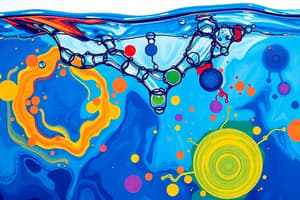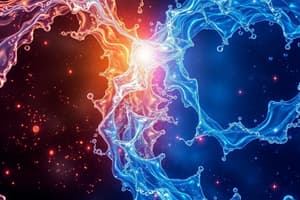Podcast
Questions and Answers
What role does hydrogen bonding play in the solubility of polar molecules in water?
What role does hydrogen bonding play in the solubility of polar molecules in water?
- It makes them less compatible with biological macromolecules.
- It allows them to interact favorably with water, increasing their solubility. (correct)
- It decreases their solubility by repelling them.
- It has no effect on the solubility of polar molecules.
How does the presence of nonpolar molecules in water affect the ordering of water molecules?
How does the presence of nonpolar molecules in water affect the ordering of water molecules?
- It forces water molecules to become more ordered to maintain hydrogen bonds. (correct)
- It has no impact on the organization of water molecules.
- It increases the hydrogen bonding capability of water.
- It decreases the order of water molecules around the nonpolar substances.
What is the primary driving force behind protein folding in aqueous environments?
What is the primary driving force behind protein folding in aqueous environments?
- The presence of enzymes that facilitate the process.
- The strong hydrogen bonding between the protein and water.
- The formation of covalent bonds between protein molecules.
- The hydrophobic effect, which is an entropic phenomenon. (correct)
In the context of thermodynamics, what effect does adding a nonpolar molecule like pentane to water have?
In the context of thermodynamics, what effect does adding a nonpolar molecule like pentane to water have?
What is the effect of the hydrophobic effect in biological systems?
What is the effect of the hydrophobic effect in biological systems?
Why is water considered a good solvent for polar and charged molecules?
Why is water considered a good solvent for polar and charged molecules?
What happens to water molecules when multiple nonpolar molecules aggregate into a glob?
What happens to water molecules when multiple nonpolar molecules aggregate into a glob?
Which statement best describes the role of non-covalent interactions in biological macromolecule structures?
Which statement best describes the role of non-covalent interactions in biological macromolecule structures?
What does a negative value of Gibbs free energy (ΔG < 0) indicate about a reaction?
What does a negative value of Gibbs free energy (ΔG < 0) indicate about a reaction?
Which factor does NOT contribute to the value of the equilibrium constant (Keq)?
Which factor does NOT contribute to the value of the equilibrium constant (Keq)?
How does a favorable entropic change (ΔS > 0) influence a chemical reaction?
How does a favorable entropic change (ΔS > 0) influence a chemical reaction?
What role does water play as a solvent in biochemical reactions?
What role does water play as a solvent in biochemical reactions?
Which of the following correctly describes thermodynamic coupling?
Which of the following correctly describes thermodynamic coupling?
What is the significance of the Gibbs free energy change (ΔGo) at standard state conditions?
What is the significance of the Gibbs free energy change (ΔGo) at standard state conditions?
How does hydrogen bonding influence protein folding?
How does hydrogen bonding influence protein folding?
What is the relationship between ΔGo and Keq?
What is the relationship between ΔGo and Keq?
What role does ATP play in metabolic reactions?
What role does ATP play in metabolic reactions?
Which property of water is primarily responsible for its ability to dissolve biological molecules?
Which property of water is primarily responsible for its ability to dissolve biological molecules?
What is the effect of extensive hydrogen bonding in water?
What is the effect of extensive hydrogen bonding in water?
How does the concentration of water in biological samples compare to other components?
How does the concentration of water in biological samples compare to other components?
What geometric arrangement do the sp3 orbitals of water's oxygen atom adopt?
What geometric arrangement do the sp3 orbitals of water's oxygen atom adopt?
Which statement best describes the interaction between water molecules?
Which statement best describes the interaction between water molecules?
What characteristic of water contributes to its unusual high boiling point compared to other similar-sized molecules?
What characteristic of water contributes to its unusual high boiling point compared to other similar-sized molecules?
What is primarily responsible for making water a good solvent for biological reactions?
What is primarily responsible for making water a good solvent for biological reactions?
Flashcards are hidden until you start studying
Study Notes
Water as a Dipole and Its Role in Solubility
- Water molecules are dipoles due to their asymmetric structure, allowing for hydrogen bonding and interactions with polar/charged molecules.
- Polar and charged molecules exhibit increased solubility in water due to favorable hydrogen bonding and charge-dipole interactions.
- Hydrogen bonds are crucial for stabilizing the structures of proteins and cell membranes.
The Hydrophobic Effect
- Nonpolar molecules (e.g., pentane) do not participate in hydrogen bonding with water, leading to an increase in order among surrounding water molecules.
- As nonpolar molecules aggregate, they reduce their surface area exposed to water, which increases the overall entropy of the water.
- The hydrophobic effect is an entropic phenomenon and is a key driver in stabilizing biomembranes, protein folding, and enzyme-substrate interactions.
Importance of Water in Biological Systems
- Water has a high molar concentration in biological samples (approximately 55 M), dominating interactions in biochemical reactions.
- Despite its simple structure, water displays unique properties, including high viscosity, a high boiling point, and a high heat of vaporization, making it an excellent solvent.
- The high boiling point and other properties arise from hydrogen bonding, leading to some degree of order in water molecules.
Structure and Bonding of Water
- Water's geometry results in a dipole moment (1.84 Debye), enabling interactions with up to four other water molecules through hydrogen bonds.
- The sharing of a hydrogen between electronegative oxygen atoms characterizes hydrogen bonding, which contributes to water's unique properties.
- Extensive hydrogen bonding in water creates order, which is thermodynamically unfavorable but compensated by favorable enthalpy.
Basic Thermodynamics Overview
- In bimolecular reactions, equilibrium occurs when concentrations of reactants (A and B) and products (C and D) remain constant.
- The equilibrium constant (K_eq) quantifies the ratio of concentrations at equilibrium: K_eq = [C][D] / [A][B].
- Gibbs free energy change (ΔG) is used to predict reaction spontaneity: ΔG = ΔH - TΔS (with ΔH representing enthalpy and ΔS representing entropy).
Free Energy and Reaction Dynamics
- A negative ΔG value indicates that a reaction is spontaneous; ΔG equals zero signifies equilibrium; a positive ΔG indicates no spontaneous reaction.
- Favorable reactions can stem from either favorable enthalpy changes (ΔH < 0) or favorable entropy changes (ΔS > 0).
- In biological systems, thermodynamically unfavorable reactions can often be driven by coupling with favorable reactions, frequently seen with ATP hydrolysis.
Studying That Suits You
Use AI to generate personalized quizzes and flashcards to suit your learning preferences.




